Bitte wählen Sie Ihren Standort und Ihre Sprache aus

What is “healthy” food? What is safe to consume? How can food manufacturers and regulatory bodies use food labeling to empower consumers to make informed choices? These important questions are front and center in today’s conversations about the United States food industry. As debates take place at federal and state levels, food manufacturers are striving to keep their labeling in line with current legal requirements.
While food labeling in the US has historically been regulated at the federal level, in 2025 we are seeing an increase in state-level food labeling regulations. From food additives to meat alternatives, states across the union are passing their own measures. This increased complexity means that food producers wishing to sell products in multiple US states are faced with a regulatory patchwork: ingredients may have labeling requirements in one state, but not in another. Compliance deadlines also vary, forcing companies to juggle constantly changing requirements across dozens of locations.
With the fast pace of regulatory change, smart labeling software helps food manufacturers stay flexible. In this blog, we’ll explore the forces behind food labeling changes, detail many of the new labeling requirements, and learn how smart label design and management keeps producers agile to changing food labeling rules.
It seems like new food labeling rules are always in the news, which can make it feel like labeling rules are always changing. Proposed rules are discussed and debated before being finalized and enforced, keeping them in the news cycle for longer.
In the US, two major changes have become enforced in the past five years: updated nutrition label requirements in 2020-2021 and required allergen labeling for sesame in 2023. Today, many more proposed food labeling changes are being considered.
Let’s dig into four reasons why food labeling rules change.
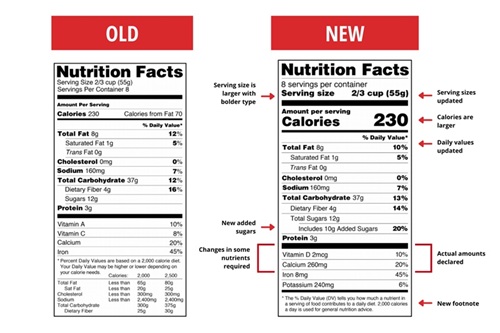 As scientific research advances, we learn more about how diet impacts health. Past assumptions are challenged by new evidence. One example is diet recommendations around fat. In the 1970s through the 1990s, nutrition policy encouraged people to cut out fat from their diets. The goal was to reduce consumption of harmful saturated fats, but people also eliminated healthy unsaturated fats from their diet. Food companies developed and promoted low-fat versions of products, which were often higher in sugars and processed carbohydrates. Further scientific research revealed that replacing saturated fat with simple carbohydrates was not effective in reducing the risk of heart disease. In the 2010s, the FDA updated the US nutrition facts label: “calories from fat” was removed and "added sugars” were newly required.
As scientific research advances, we learn more about how diet impacts health. Past assumptions are challenged by new evidence. One example is diet recommendations around fat. In the 1970s through the 1990s, nutrition policy encouraged people to cut out fat from their diets. The goal was to reduce consumption of harmful saturated fats, but people also eliminated healthy unsaturated fats from their diet. Food companies developed and promoted low-fat versions of products, which were often higher in sugars and processed carbohydrates. Further scientific research revealed that replacing saturated fat with simple carbohydrates was not effective in reducing the risk of heart disease. In the 2010s, the FDA updated the US nutrition facts label: “calories from fat” was removed and "added sugars” were newly required.
Scientific research also led to changes in the required vitamins and percent Daily Value on the US nutrition label.
Learn more and download US and EU nutrition label samples
Scientific research never stops, and as new findings are made, regulators must stay ahead to keep consumers safe and informed. However, scientific research is not fast, and small one-off studies aren’t enough to prompt new legal requirements. Additional research and peer review are crucial to the scientific process, and these take time.
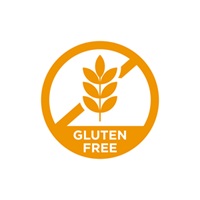 Food allergies and intolerances have increased over the past decades. As these become more common, allergen labeling becomes more critical. In 2023, sesame was added to the US list of common allergens that must be clearly labeled.
Food allergies and intolerances have increased over the past decades. As these become more common, allergen labeling becomes more critical. In 2023, sesame was added to the US list of common allergens that must be clearly labeled.
Wheat has been on the US allergens list since it was implemented in 2006. As gluten intolerance and celiac disease became more common, food companies added voluntary “gluten free” labels to packaging to signal safety to those consumers.
Not all food labeling changes come from regulations, and many labeling changes are a result of changing consumer preferences. Various diets, such as paleo, keto, and plant-based, have become more popular in recent years. Food companies lock into these trends and change their labels to appeal to customers following these diets.
Very closely tied to consumer preferences is food marketing. Food companies spend significant budgets on market research into the latest consumer preferences and trends. This research informs food labeling decisions that may or may not be regulated.
Food marketing labels regulated in the US include:
Some official-looking food labels aren’t regulated by the government, but by private non-profit and for-profit companies. These organizations certify products to align with nutrition, supply chain, environmental, and religious standards. Privately certified food labels include:
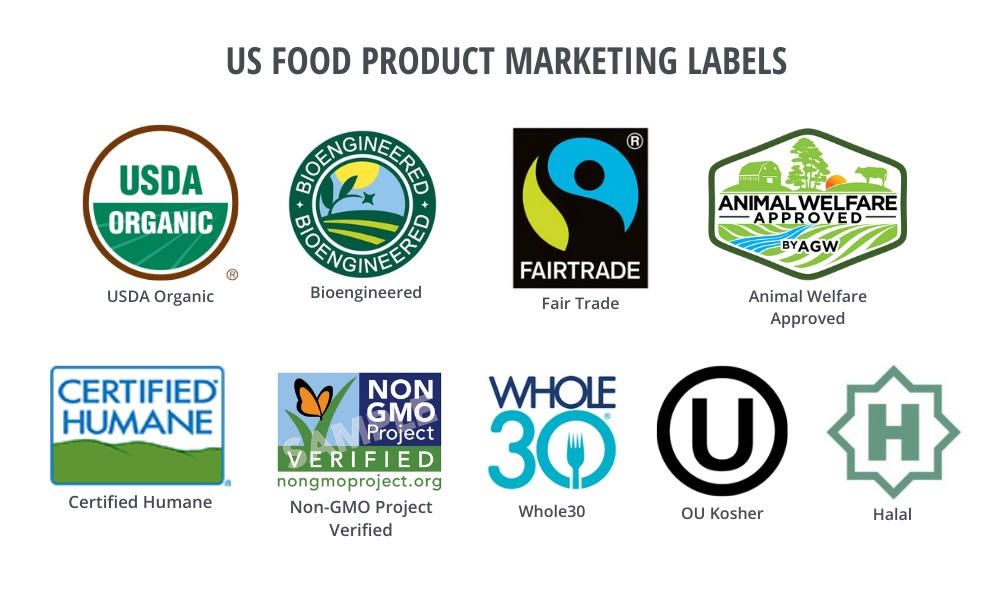
Non-regulated food marketing labeling includes statements that entice consumers to buy but don’t have specific rules enforcing them. These may include “clean,” “natural,” “local,” “sustainable,” or “real,” which have no official definitions but attract consumers looking to eat healthier.
As new scientific research emerges and consumer preferences intensify, politicians leverage these issues to activate their voters and garner support. Once in office, politicians may propose, sponsor, and vote for legislation supporting new food labeling rules.
In addition to the interests of voters, politicians in the US are often influenced by lobbying organizations. The nonpartisan group, OpenSecrets, reported that the food industry spent over $29 million on lobbying in 2024. A 2024 study by the Milbank Memorial Fund found that the ultra-processed food industry spent $1.15 billion on lobbying between 1998 and 2020. These large amounts of money can result in stronger, weaker, or different food labeling rules, as well as complex loopholes that exempt businesses from action.
All of the factors discussed above are highly relevant today, prompting new federal and state-level food labeling laws across the US.
These food labeling changes affect all food producers that sell food in the US (domestic or imported).
In December 2024, the FDA finalized the updated rule regarding “healthy” claims on food labels, which previously hadn’t been updated since the 1990s. The updated rules, which went into effect in April 2025, allow manufacturers to label the following foods as “healthy”:
Foods that may no longer be labeled “healthy” include fortified white bread, highly sweetened yogurt, and highly sweetened cereal.
The Food Safety Modernization Act was established to improve food safety throughout the supply chain. FSMA Rule 204 establishes specific traceability requirements for foods on the Food Traceability List (FTL) which are more likely to transmit foodborne illnesses. This labeling law is less visible to consumers, but instrumental in protecting the safety of the food supply chain. Strong traceability allows fast and efficient recalls in the event of contamination.
FSMA Rule 204 is officially set to be enforced in January 2026, although the FDA has proposed extending the deadline to July 2028.
Today, the US has no front-of-package nutrition labeling requirements, unlike Mexico, Canada, and countries in the European Union. The FDA has proposed new front-of-package nutrition labeling to help consumers quickly understand the nutrition profile of a food product.
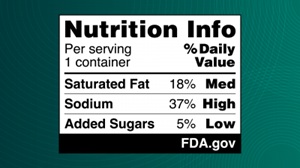
The proposed label would designate a product as “Low,” “Medium,” or “High” in saturated fat, sodium, and added sugars. Manufacturers could voluntarily declare calories in the front-of-package label.
The comment period for this proposed rule is over, and the FDA will now decide whether to issue a final rule, issue a new proposed rule with a new commenting period, or end the rulemaking process.
The bipartisan Food Date Labeling Act was first introduced in Congress in 2023, aiming to standardize food date labels to reduce consumer confusion and related food waste. It has not yet been passed and was reintroduced in 2025. Currently, there is no federal regulation for food date labels, except for infant formula.
The proposed legislation would define two standard phrases for food date labeling:
Alcoholic beverages are regulated in the US by the Alcohol and Tobacco Tax and Trade Bureau (TTB), not the FDA. This is why alcoholic beverages aren't required to include nutrition facts, ingredients lists, or allergen statements.
Between 2016 and 2021, the Beer Institute announced an industry push called the Brewers’ Voluntary Disclosure Initiative (BVDI), which encouraged beverage producers to voluntarily include a serving facts statement (similar to a nutrition facts label) and ingredients list. In 2021, the Beer Institute reported that 95% of beer volume sold by five major brewers provided nutritional information.
Industry initiatives can only go so far. The BVDI is only for the beer sub-industry and is completely optional. Its impressive-looking results are based on participating companies, not the total beer market.
Following pressure from advocacy groups, in January 2025 the TTB published two proposed rules that would require an “alcohol facts” label and allergen labeling on alcoholic beverage products sold in the US. The commenting period ended in August 2025, and the industry and consumers now await a final rule.
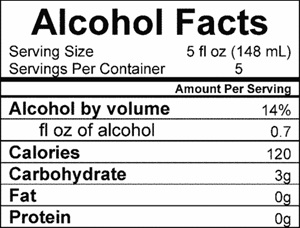
Many US states have recently proposed or finalized new food labeling laws. Food companies that sell across state lines must stay aware of new labeling requirements to maintain compliance and avoid fines. Here’s a look at new food labeling rules in US states.
In June 2025, Texas’ governor signed a new labeling requirement into law that affects a broad range of products. The law requires a warning label on food products containing 44 specific additives, many of which are commonly found in the US food market.
The warning must state, “WARNING: This product contains an ingredient that is not recommended for human consumption by the appropriate authority in Australia, Canada, the European Union, or the United Kingdom.”
Critics of the new rule argue that several of the additives named in the list are actually approved for use in the specified regions, making the warning statement inaccurate and confusing. The list also includes at least three additives that are already banned in the US at the federal level.
Food labels developed or copyrighted January 1, 2027, or later must comply with this new labeling rule or face fines of up to $50,000 per day per product. Companies will now decide whether to add the warning label, reformulate their products (still requiring labeling updates to the ingredients list), or stop selling products in Texas.
Similar to its neighbor, Louisiana passed a food additive labeling rule in June 2025. It also targets 44 additives, most of which overlap with the Texas law.
Differing from the Texas law, food sold in Louisiana will be required to include a QR code linking to the manufacturer’s website. The website must then display the warning: “NOTICE: This product contains [insert ingredient here]. For more information about this ingredient, including FDA approvals, click HERE" with a link to the US Food and Drug Administration (FDA) food chemical safety website.
Compliance with the Louisiana labeling rule is required by January 1, 2028.
Not waiting for US Congress to pass the federal Food Date Labeling Act, California enacted its own food date labeling law. While it doesn’t require dates, it specifies the language that may be used if a date label is included. Only “Best if used by” or “Use by” dates will be allowed. Other date label phrases are banned as of the law’s effective date of July 1, 2026.
The National Agricultural Law Center (NALC) tracks and reports on state-level food labeling laws. Here are three new labeling requirements enacted in 2025:
In January 2025, North Dakota passed a law creating a labeling requirement for raw milk and raw milk products to be labeled as “raw milk” or “made with raw milk”.
South Dakota already had labeling rules in place for alternative proteins, requiring that the term “meat” could only be applied to products derived from actual animals. Its updated rule now specifically states that cell-cultured protein cannot lawfully be labeled as “meat”.
Utah’s new labeling requirement covers both cell-cultured protein and plant or insect-based meat substitutes. These products must be labeled clearly and reasonably.
NALC notes that 18 states now have rules for labeling alternative proteins.
In 2022, Health Canada published new regulations requiring front-of-package nutrition symbols. Following a transition period, the front-of-package nutrition symbol will be required starting January 1, 2026.

The Canadian front-of-package nutrition symbol is required on prepackaged food products that meet or exceed saturated fat, sugar, or sodium levels set by Health Canada. The levels that trigger the label vary depending on the reference amount, or typical serving quantity as defined by the Table of Reference Amounts.
Food manufacturers selling products in Canada should ensure they understand the front-of-package requirements for each product they sell and be ready for compliance by the end of 2025.
The right labeling software can help your company stay ahead of food labeling changes. Clunky, inefficient systems make responding to labeling changes difficult. Robust label design, approval, and management software lays a foundation for easy compliance.
It all starts with designing an effective label template with features that make it flexible to many product varieties and potential future changes.
Variable data is the first basic step of effective label design. Instead of creating a new label file for every product variety, label designers should use variable data to populate a template.
For food producers, this could mean having one template that’s used across a product line. The structure of the label stays the same, but the content in each object changes based on the selected product. The same template can be used for different product varieties, flavors, sizes, and even markets.
To comply with varying labeling regulations across states, a food label could include a variable text field for state-specific requirements. At print time, the product and state are selected, and the correct statements are printed on the label.
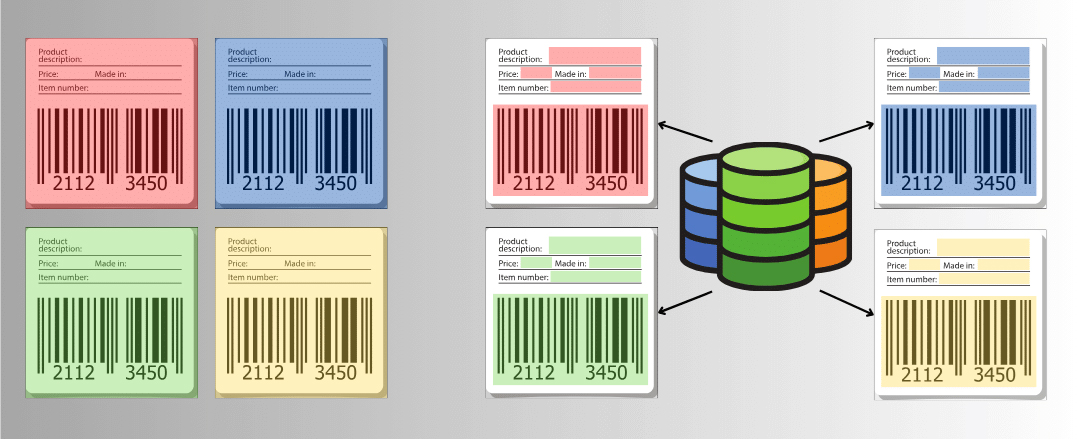
Once you understand how to create label templates with variable data, the next step is connecting your label design to the data source. Your business database should contain up-to-date data, including the product name, product variety, package weight, nutrition information, ingredients, allergen statements, marketing statements, and other regulatory statements. Connect your label to your database and use these fields as data sources for your label objects.

Other ways to use database connections include:
CODESOFT label design software includes these features and more for efficient, smart food labeling.
Smart label design software allows you to create flexible, robust food labels that meet compliance requirements. To prevent unintended changes to your label templates, you need label security and traceability software.
Start by defining roles within the label design process at your company. One individual or team should be responsible for designing and editing label templates. Another individual or team should be responsible for approving or rejecting those designs. Users who print the labels shouldn’t have access to design and approval features so that only approved labels can be printed on the production floor.

Once roles are defined, set up an approval process to govern new and updated label templates. At smaller companies, this might be two to three steps. In larger organizations, labeling changes might need approval from multiple departments and stakeholders.
LABEL ARCHIVE label security and traceability software empowers organizations to take control of their label approval process and offers additional features for file organization and auditing.
With several major food labeling changes coming to the US market and beyond, make sure your company is prepared with the right labeling technology. Talk to a food labeling expert at TEKLYNX today.
I want to talk about food labeling
Meaghan Wittmann is the Digital Marketing Manager at TEKLYNX. She leads the strategy behind TEKLYNX’ digital presence, from educational content and customer resources to digital channels that connect manufacturers with the labeling solutions they need to work better. Passionate about helping customers succeed, Meaghan focuses on delivering digital experiences that make it easier for businesses to navigate labeling challenges.
In today's health-conscious world, ingredient labels are more than a list of components. They’re a tool for consumer safety, transparency, and trust. According to Food Allergy Research & Education (FARE), every 1 in 10 adults has a food allergy and has experienced a severe reaction. Whether you’re in the food & beverage, cosmetics, cannabis, or pharmaceutical industry, ensuring that your ingredient labels are accurate and compliant with regulatory standards is essential.
READ MORE
The nutrition label is a critical piece of information for consumers when making purchasing decisions, but for food manufacturing companies, the label is much more than calories and an ingredient list. Although changes to food labeling requirements are infrequent, when changes are made, they can be substantial. Read the blog to learn how to comply.
READ MORE
How can companies best manage compliance labeling? A reliable enterprise labeling system enables smart label templates, an audit-ready label approval process, software validation, and barcode verification. In this blog we’ll explore how these enterprise labeling features help companies manage compliance labeling.
READ MORE© Copyright 2025 TEKLYNX CORPORATION SAS. Alle Rechte vorbehalten.
What do you think? Leave us a comment.
Comments will be reviewed and are subject to TEKLYNX’ comment policy. Your email address will not be published publicly.